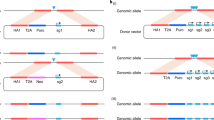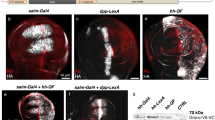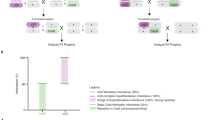Abstract
We describe a microinjection-based φC31 integrase mRNA-mediated method for creating transgenic Drosophila strains. This approach is more efficient than traditional methods and ensures that the transgene is targeted to a precise genomic position. The method involves targeting integration of an exogenous plasmid (containing the transgene and sequences to facilitate integration) to a preplaced recipient site in the Drosophila genome. The plasmid is coinjected into embryos with mRNA encoding the φC31 integrase, the enzyme that catalyzes the integration reaction. Using the protocol described here, transgenic lines can be established from, on average, 46% of fertile adults obtained after injection, and all integrations should be targeted to the chosen genomic insertion site. The whole procedure, from injection to established transgenic stocks, can be completed in three generations (approximately 1 month) and can be adapted for other types of transgenesis and mRNA injections in Drosophila.
This is a preview of subscription content, access via your institution
Access options
Subscribe to this journal
Receive 12 print issues and online access
$259.00 per year
only $21.58 per issue
Buy this article
- Purchase on Springer Link
- Instant access to full article PDF
Prices may be subject to local taxes which are calculated during checkout




Similar content being viewed by others
References
Rubin, G.M. & Spradling, A.C. Genetic transformation of Drosophila with transposable element vectors. Science 218, 348–353 (1982).
Brand, A.H. & Perrimon, N. Targeted gene expression as a means of altering cell fates and generating dominant phenotypes. Development 118, 401–415 (1993).
Xu, T. & Rubin, G.M. Analysis of genetic mosaics in developing and adult Drosophila tissues. Development 117, 1223–1237 (1993).
Groth, A.C., Olivares, E.C., Thyagarajan, B. & Calos, M.P. A phage integrase directs efficient site-specific integration in human cells. Proc. Natl. Acad. Sci. USA 97, 5995–6000 (2000).
Allen, B.G. & Weeks, D.L. Transgenic Xenopus laevis embryos can be generated using φC31 integrase. Nat. Methods 2, 975–979 (2005).
Nimmo, D.D., Alphey, L., Meredith, J.M. & Eggleston, P. High efficiency site-specific genetic engineering of the mosquito genome. Insect Mol. Biol. 15, 129–136 (2006).
Groth, A.C., Fish, M., Nusse, R. & Calos, M.P. Construction of transgenic Drosophila by using the site-specific integrase from phage φC31. Genetics 166, 1775–1782 (2004).
Bateman, J.R., Lee, A.M. & Wu, C.T. Site-specific transformation of Drosophila via φC31 integrase-mediated cassette exchange. Genetics 173, 769–777 (2006).
Venken, K.J.T., He, Y., Hoskins, R.A. & Bellen, H.J. P[acman]: a BAC transgenic platform for targeted insertion of large DNA fragments in D. melanogaster. Science 314, 1747–1751 (2006).
Bischof, J., Maeda, R.K., Hediger, M., Karch, F. & Basler, K. An optimized transgenesis system for Drosophila using germ-line-specific φC31 integrases. Proc. Natl. Acad. Sci. USA 104, 3312–3317 (2007).
Hollis, R.P. et al. Phage integrases for the construction and manipulation of transgenic animals. Reprod. Biol. Endocrinol. 1, 79 (2003).
Miller, D.F., Holtzman, S.L. & Kaufman, T.C. Customized microinjection glass capillary needles for P-element transformations in Drosophila melanogaster. Biotechniques 33, 366–372 (2002).
Acknowledgements
This work is dedicated to the memory of my son Lance Raymond Fish (July 30, 2004 to April 30, 2007).
Author information
Authors and Affiliations
Corresponding author
Rights and permissions
About this article
Cite this article
Fish, M., Groth, A., Calos, M. et al. Creating transgenic Drosophila by microinjecting the site-specific φC31 integrase mRNA and a transgene-containing donor plasmid. Nat Protoc 2, 2325–2331 (2007). https://doi.org/10.1038/nprot.2007.328
Published:
Issue Date:
DOI: https://doi.org/10.1038/nprot.2007.328
This article is cited by
-
A versatile toolkit for CRISPR-Cas13-based RNA manipulation in Drosophila
Genome Biology (2020)
-
Mutagenesis mediated by CRISPR/Cas9 in the red imported fire ant, Solenopsis invicta
Insectes Sociaux (2020)
-
The Hippo pathway acts downstream of the Hedgehog signaling to regulate follicle stem cell maintenance in the Drosophila ovary
Scientific Reports (2017)
-
In vivo analysis of internal ribosome entry at the Hairless locus by genome engineering in Drosophila
Scientific Reports (2016)
-
Generation of a transgenic ORFeome library in Drosophila
Nature Protocols (2014)
Comments
By submitting a comment you agree to abide by our Terms and Community Guidelines. If you find something abusive or that does not comply with our terms or guidelines please flag it as inappropriate.



